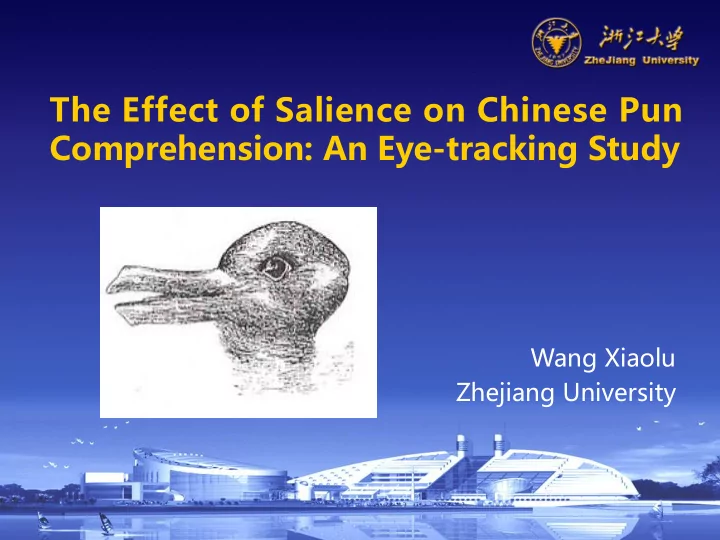

The Effect of Salience on Chinese Pun Comprehension: An Eye-tracking Study Wang Xiaolu Zhejiang University
Contents • 1. Introduction • 2. Research Question • 3. Eye-tracking Experiment • 4. Results and Discussion • 5. Conclusion
1. Introduction • Puns are prevalent in daily language use. – During branding, cowboys have sore calves. (Coulson 2007) – 东边日出西边雨,道是无晴却有晴/情。
1. Introduction • Pun is a special case of ambiguity, where two meanings are accessed and maintained at the same time. – Accessed in what way? • 晴-情 • 情-晴 • 晴 情
1. Introduction • The Visual World Paradigm (VWP) Target Distractor Phonological competitor Distractor
1. Introduction • Findings indicate that the fixation proportion on the picture referents is modulated by: – phonological information – semantic information – shape information (Allopenna, Magnuson, & T anenhaus, 1998, Huettig & McQueen, 2007) • Weakness of the VWP – pictures have to be used
1. Introduction • The Visual World Paradigm (printed-word version) car
1. Introduction • Studies from English and Dutch show that fixation proportion on the printed-words is still found modulated by – phonological /orthographic information – maybe not by semantic information
1. Introduction • Shen, W., Qu, Q. Q., & Li, X. S. (2016): short- preview condition Distractor Semantic competitor (school) (nurse) Distractor Phonological competitor (hanger) (insect)
1. Introduction • Shen, W., Qu, Q. Q., & Li, X. S. (2016). Semantic competitor Phonological competitor Distractor
2. Research Question • Is the salient meaning accessed earlier in the context of Chinese puns as predicted by the graded salience hypothesis?
3. Experiment Material & Design • Auditory Stimuli – replication condition: 40 unambiguous sentences – pun condition: 40 pun sentences – 80 filler sentences; 4 blocks – mostly from newspaper headlines – recorded by a female native Chinese speaker sampled at 44.1 kHz
3. Experiment Material & Design • Visual Stimuli – 80 printed-word quadraplet – Two-character Chinese words matched in word frequency, and the total number of word strokes. – Semantic competitors ( Mean >3); phonological competitors or the distractors ( Mean <2).
3. Experiment Material & Design • Visual Stimuli – Meaning salience: cross-modal lexical decision task. Semantic Competitor 1 = salient meaning (shorter RT) Semantic Competitor 2 = less salient meaning (longer RT) – Screen location counterbalanced
3. Experiment • Participants – 27 college students (mean age= 21.2, SD= 2.0) – normal or corrected to normal vision • Apparatus – Eyelink 1000 plus sampled at 1000 Hz – 19-in. monitor seated 60cm from participants, 75 Hz refresh rate, 1024*768 pixels resolution – chin rest with forehead support
3. Experiment • Experiment structure:
3. Experiment • An example trial of the pun condition Phonological Distractor competitor Semantic Semantic competitor 1 competitor 2
4. Results • Playback of an example trial in aggregate mode: Phonological Distractor competitor Semantic Semantic competitor 1 competitor 2 中国大学,请不要被排行绑了。
4. Results • Fixation proportion to different competitors: (pun condition) Salience effect
4. Results • Statistical analysis (pun condition) – Logit mixed models – Global analysis: 200-800ms; 800-1400ms – Local analysis: 800-1000ms; 1000-1200ms; 1000-1200ms – p value: Bonferroni correction
4. Results • Statistical results (pun condition) – Salient meaning (Semantic competitor 1 ) received significantly more fixations than the less salient meaning (Semantic competitor 2) during the 200- 800ms time window ( p = 0.013*) Predictor Estimate SE Wald-Z Adjusted p distractor (Intercept) Semantic competitor 1 0.26 0.09 2.79 <0.01** Semantic competitor 2 -0.22 0.09 -2.48 0.013* Phonological competitor -0.22 0.09 -2.49 0.012*
4. Results • Statistical results (pun condition) – However, global analysis in the 800-1400ms time window shows no such difference ( p = 0.45) Predictor Estimate SE Wald-Z Adjusted p (Intercept) Semantic competitor 1 0.28 0.07 4.06 <0.001*** Semantic competitor 2 -0.07 0.09 -0.76 0.45 Phonological competitor -0.45 0.09 -4.87 <0.001***
4. Results • Statistical results (pun condition) – Still, the local analysis in the 800-1000ms time window (approximately 200ms after the pun word offset) reveals that semantic competitor 1 receives more fixation than the semantic competitor 2. ( p = 0.04*) Predictor Estimate SE Wald-Z Adjusted p (Intercept) Semantic competitor 1 -0.45 0.06 -7.22 <0.001*** Semantic competitor 2 -0.18 0.09 -2.05 0.04* Phonological competitor -0.58 0.09 -6.17 <0.001***
4. Discussion • Chinese par ticipants fixated more on the semantically-related words compared to the distractors. – Different from research on alphabetic languages (e.g. English and Dutch), where no such semantic effect was reliably found. – Alphabetic languages have a stronger orthographic form-sound connection; logographic languages, such as Chinese, have stronger orthographic form-meaning relation. – The printed version of the VWP is applicable to semantic research on Chinese .
4. Discussion • Salient meanings of the pun word are accessed first when listening to Chinese puns. – Cognitive advantage of salient meanings – Lend support to the graded salience hypothesis proposed by Giora (2003).
5. Conclusion • Pun comprehension is guided by meaning salience associated with the pun word. • Pun experience may vary with the different linguistic experience of the pun receiver. • The printed word VWP is a valid and promising tool for semantic research on Chinese.
感 谢 聆 听
Recommend
More recommend